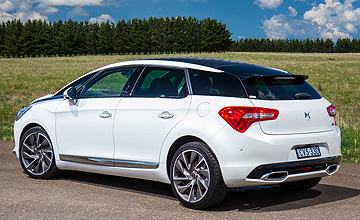BY ROBBIE WALLIS AND TIM ROBSON | 30th Oct 2015

There is a lot of residual love for the DS moniker it graced some of the most amazing mass-produced cars produced anywhere in the world. In the 1950s and 1960s DSs were driven by movie stars, royals and genuine celebrities, while its ride – based on Citroen’s still-used interconnected air sphere/hydraulic fluid damping system – is still regarded as one of the most cosseting ever produced.
Many of the car’s fans during our test were die-hard aficionados of the DS legacy – and, in part, it’s to this audience that the new-generation DS must appeal, as well as bringing new buyers into the fold.
The DS5 in Citroen guise has not had much of an impact on the new car market this year, with just 45 cars sold. More than 35 of those, however, have been diesels, so DS Australia has opted to update the former Citroen DS5 with PSA group’s high-performance diesel engine, coupled to a six-speed automatic transmission. That’s it – just the one powertrain will be offered.
It’s a brave call even if one engine is favoured over another and taking away the ability for customers to choose is pretty significant. While diesels do well on longer journeys, they’re less happy doing shorter runs in an urban environment, for example, which may limit the $56,990 (plus ORCs) DS5’s audience.
Design-wise, the unusual DS5 hits the right notes with passers-by, and it cuts an impressive figure in the Melbourne morning peak. The newly designed front and rear LED lights help here, as do simple but striking new alloys.
The interior, too, is light years away from everything else in the sector.
Unique and interesting control panels and surfaces are punctuated by clever touches like the stylised analogue clock and red anodised switchgear, along with a large and clear centre touchscreen. Unfortunately, the dash does throw up reflections onto the windscreen at inopportune moments.
The front pews – covered in only the world’s finest leathers, if you don’t mind – are supportive and very comfortable, while the backs seats are equally cushy.
Leg room in the rear is compromised for taller passengers, though. The large steering wheel feels like a throwback to the DS’s roots, too, and is comfortable underhand.
Equipped with the 133kW, 400Nm BlueHDi 180HP four-cylinder, 2.0-litre diesel and six-speed Aisin-developed auto, the DS5 motors along in relative silence.
The occasional diesel chug can be made out in the cabin under acceleration, but quickly fades in cruise mode. It’s a well resolved package and suits the car well.
The chassis, though... this is an area where DS needs to excel to make the most of its legacy, but in the ageing DS5, it hasn’t shown its best hand out of the blocks. DS engineers maintain that they can replicate the magic carpet ride that the original DS is so famous for with (less complex and expensive) springs and dampers… but in this case, they’ve missed the mark.
Initial bump compliance is surprisingly firm, and magnified at slow city speeds. Bumps that should disappear just don’t. While things improve out of town, it’s the steering that then lets the side down.
Based on the PF1 platform that underpins Peugeot’s 508, the hydraulic steering feels heavy and vague, while rack rattle and shimmy on mid-corner bumps is disappointingly noticeable, and occasionally borders on severe.
The PSA group’s EMP2 platform is a much more refined proposition, and with new DS models in the pipeline ahead of an expected brand push in 2018, we’d be surprised not to see it appear underneath more than one of the brand’s upcoming models.
So it’s a somewhat inauspicious start for DS Automotive in Australia, but this is a long game. In fact, the company doesn’t believe it can call itself a standalone car company until two model cycles – about fifteen years – have passed. With this in mind, we’ll keep a keen eye on Australia’s newest car brand.